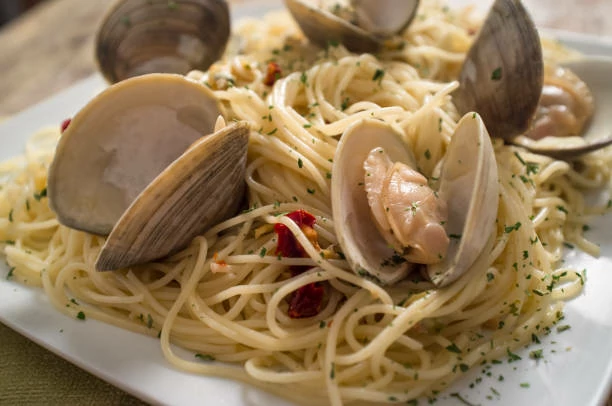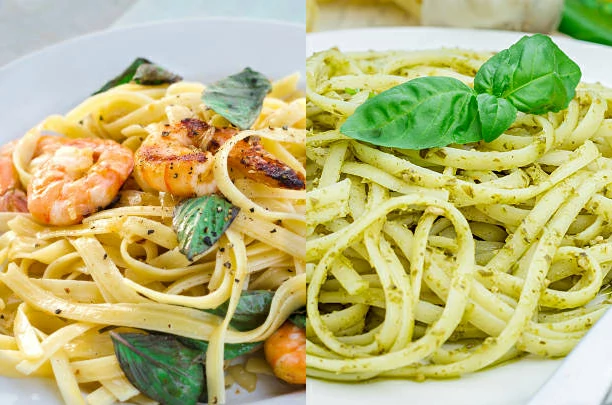Linguine vs fettuccine, can you tell them apart if come to you either cooked or uncooked? For people who cannot differentiate between a variety of pasta types, here’s an easy way to understand the difference.
If you’re a crazy pasta lover and have tried cooking various pasta types, you may have an idea how all these types contradict each other in terms of thickness, length, shape, and cooking or serving ways.
So, it’s time to make all these differences unambiguous.
Linguine Vs Fettuccine
Linguine and fettuccine are similar to each other to an appreciable extent. But what makes them different or what makes them so confusing to be distinguished?
Linguine resembles not only fettuccine but also many other types of pasta, spaghetti, and tagliatelle. However, the main difference between fettuccine and linguine is their shape. Linguine is more rounded and thinner than flat or thicker fettuccine.
Besides shape, there are lot more other dissimilarities you must know to conquer the world of pasta. Let’s know other linguine vs fettuccine facts to understand them in detail. Surely, it will enable you to tell these pasta kinds apart in first glance.
Read also: Parmesan Rind Substitute
Common Names
The word linguine means “small tongues” refer to long, thinner, and rounder pasta. While the word fettuccine means “small ribbons” refer to flat, thicker, and wider pasta.
Ingredients
Linguine is made of flour and water without using any kind of binding ingredient. Usually, wheat or white flour is preferred for its significant gluten content to support the texture of linguine.
On the other hand, fettuccine is made of flour, water and eggs to support and hold the thick texture of pasta.
How To Make?
Linguine noodles, due to limited ingredients, are fragile and thinner, thereby better to make using a pasta maker. This is the fact that makes them difficult to handle at home.
While this is not the case for fettuccine noodles. As fettuccine has eggs as binding ingredients, it’s easy to make manually.
Simply, knead the ingredients, roll out the dough and cut it into large ribbons or strips of usually 3 millimeters wider. If you have a pasta maker, fettuccine is one of the convenient and heartier pasta kinds to make.
Appearance
Fettuccine is much wider, thicker, and flatter to perceive while linguine is more elliptical, narrower, thinner, and has an oval-shaped cross section. It’s the basic difference that makes the whole linguine vs fettuccine discussion clear and you can understand these two pasta kinds differently.
Thickness
What’s the difference between fettuccine and linguine, you can point out at first glance? Check out the thickness of both satisfying types of pasta.
Fettuccine is quite thicker than linguine, while you can easily point out linguine for its narrower texture.
It’s the thickness that make these two pastas compliment well with different serving sauces and other pairing ingredients.
Serving Style

Not limited to shape or appearance, these two are also differently served.
Linguine noodles pair well with seafood like shrimp, pesto, cheese, and so many culinary herbs. Sometimes, fresh salad and toasted garlic bread are also served with linguine to make it heartier and more satisfying.
However, this is not the case for fettuccine noodles. Fettuccine is best to serve with Alfredo, porcini, and Bolognese. It wonderfully pairs with grilled chicken, meatballs, bacon, salad, and sauteed white or green asparagus.
You may also Like: Substitutes For Worcestershire Sauce
Linguine Vs Fettuccine: Ideal Sauce To Make!
Have you ever noticed that fettuccine is usually served with Alfredo and sauces like Alfredo? Even fettuccine Alfredo is the most popular dish in America. This is because its flat yet thicker texture is perfect to serve with thick sauces like Alfredo, Al burro, carbonara, Bolognese, and other meaty sauces.
While linguine is usually served with thin sauces like pesto, steak sauce, oil-based sauces, and a variety of tomato-flavored sauces. This is because its delicate and fragile texture fits better with thin sauces rather than being disappeared in thick sauces.
Which One Is Vegan-Friendly?
Another difference between fettuccine and linguine is their vegan-friendly nature. Most often, pasta kinds are vegan friendly and are made without any involvement of animal products.
But this is not the case for these two candidates. As you have seen above, fettuccine noodles are made of eggs and flour, thus not suitable for a vegan diet. On the other hand, linguine noodles involve only flour and water, thus are greatly preferred by vegans.
Linguine Vs Fettuccine: Which Is Better?
After knowing the difference between fettuccine and linguine, it’s hard to choose which is better. But you can still decide which is best to go with on the basis of certain diet habits.
For instance, fettuccine is greatly associated with super thick and creamy sauces such as Alfredo, heavy cream, lots of cheese, and meaty sauces, and thereby rich in calories and fats. So, if you’re craving creamy and a satisfying bowl of pasta, go with fettuccine.
In contrast, linguine is much healthier to make using thinner sauces such as pesto or olive oil. Some linguine versions are vegan friendly and thus involve light green vegetables while others are associated with seafood like shrimp or fish.
No doubt, both these kinds are ultimately delicious and umami. So, go for linguine if you want to cut extra calories in your diet or looking for something light and healthy yet flavorful.
Can You Substitute Linguine For Fettuccine?
Since both are two sides of the same picture and are kinds of pasta, so linguine can always substitute fettuccine in your beloved recipes. In fact, linguine is often substituted for fettuccine in home kitchens in routine practices.
But this time, you have to cook linguine with thinner sauces and comparable light ingredients rather than super creamy and thick meaty sauces.
So, if you are looking for a fettuccine substitute best for Alfredo sauce, linguine may not work the same. Here, you can use a lot more other alternatives to fettuccine such as tagliatelle, pappardelle, and taglierini.
All these pasta noodles are similarly thick, flavorful, flat, and longer as fettuccine. So, go for any of them you loved the most or have it on hand at the point of making a thanksgiving meal.
Can You Substitute Fettuccine For Linguine?
Since fettuccine is readily available and more versatile pasta, it can easily substitute linguine in so many Italian cuisines. Moreover, fettuccine always wins whenever comes to self-making at home instead of linguine.
It’s easy to assemble ingredients and cut the dough into wide strips at home. Fettuccine is also more flavorful and mouth-watering.
However, you can also substitute linguine with trenette or spaghetti which are closer to linguine in terms of texture and ingredient profile. So, pick the one which compliments well to your desired recipe to replace linguine rather than using fettuccine.
Linguine Vs Fettuccine: Which One Is More Versatile?
Despite the difference between fettuccine and linguine, both these noodles have their own culinary significance. In terms of versatility, linguine always wins and this is because it’s the first bet of people who are diet conscious and want to reduce daily calorie intake.
Moreover, linguine is heavily popular in Italian cuisines because of its propensity to pair with a variety of sauces and other serving ingredients.
As linguine is made of only flour and water, so it’s vegan-friendly in contrast to fettuccine.
Linguine dishes are served all year round while fettuccine is a winter staple. One can cook linguine with either seafood, vegetables, oil-based or tomato-flavored sauces. Linguine can also go best with one or more thick sauces such as carbonara and others until the sauce is not as thick as Alfredo.
Read also: Ya Cai Substitute
FAQ’s
Does Linguine And Spaghetti The Same?
Although both are quite similar to each other, linguine and spaghetti are vastly different varieties of pasta. Linguine is much more elliptical and a bit wider than spaghetti. While spaghetti is thin and rounded overall. When compared to each other, linguine is always the winner because it can hold so many sauces than spaghetti.
Despite their difference, they are still interchangeable in some Italian cuisines and are loved hugely.
Linguine Vs Fettuccine: Is There A Real Winner?
It all depends on your respective recipe and your diet preferences. Want to enjoy creamy goodness of thick sauces, go for fettuccine and if looking for something healthy or light, linguine is the best bet to go with.
Linguine is usually served with pesto, herbs, and seafood, while fettuccine is best with Alfredo and carbonara.
Can I Substitute Egg Noodles For Fettuccine?
And the answer is yes, you can. This is because egg noodles also incorporate a similar ingredient profile as fettuccine with a little texture or appearance contrast.
So, substitute the same quantity of fettuccine with an equal amount of egg noodles and enjoy. There will be no flavor deviation when you cook them the same way as fettuccine.
Is Carbonara And Alfredo Sauce The Same?
No, carbonara and Alfredo sauce are not the same. In fact, you can easily tell them apart as their texture is different.
Alfredo sauce contain heavy cream and buttery goodness, so it’s a thick gooey sauce. On the other hand, carbonara includes raw eggs, grated cheese, and a bit of pasta water, which results in sauce not as thick as Alfredo. They are also quite different in flavor and their wide culinary applications.
